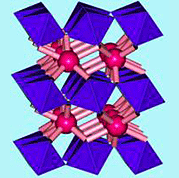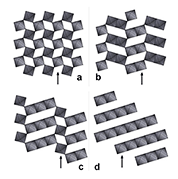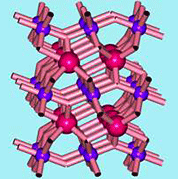Новые минералы
Новые формы минералов под высоким давлением
Симуляции из первых приципов для исследования материи внутри Земли
Discovery of MgSiO3 post-perovskite
Until the year 2004 it was believed that MgSiO3 perovskite is stable throughout the Earth’s lower mantle. Comprising ~75 vol.% of this part of our planet, perovskite turns out to be the most abundant mineral in the Earth. Properties of this phase have been extensively studied using advanced experimental and theoretical techniques and have been used to interpret geophysical observations. Though largely successful, these interpretations spectacularly failed for the lowermost ~150 km of the mantle, the so called D’’ layer. This layer is characterised by large seismic anisotropy, heterogeneity, variable depth, strong shear wave velocity discontinuity at the top, and anticorrelation between shear and bulk sound velocities. The possibility of explaining these and other observations by a phase transition was suggested by Sidorin et al. in 1998-1999, but no appropriate transition was known at the time.
A key to these mysteries came from an unexpected side, from extensive studies of high-pressure behaviour of Fe2O3 conducted by S. Ono (Institute for Frontier Research on Earth’s Evolution, Japan) in 2002-2003. S. Ono found that, like MgSiO3, Fe2O3 changes structure from corundum type to perovskite type. On further compression, a new phase was formed, and its was found to have a layered CaIrO3-type structure (space group Cmcm). The hypothesis put forward by S.Ono was that MgSiO3 could also adopt a CaIrO3-type structure in a post-perovskite phase.
With this idea in mind, I computationally explored the phase diagram of MgSiO3 and found that at conditions of the Earth’s D’’ layer (pressures ~125-136 GPa, temperatures ~2700-4000 K) MgSiO3 should indeed transform from the perovskite into the CaIrO3-type structure. The ab initio phase diagram was used by S. Ono to successfully synthesise the post-perovskite phase of MgSiO3. The theoretical and experimental phase diagrams were in good agreement with each other. Moreover, the Clapeyron slope and seismic discontinuities corresponding to this transition match very well seismological inferences of Sidorin et al. (1998-1999), and explain most of the puzzling properties of the D’’ layer. Elastic anisotropy of this phase, as calculated ab initio, matches the observed anisotropy of the D'' layer, the conditions of stability of this phase match the depth of the D'' discontinuity, its large Clapeyron slope explains the topography of this discontinuity, and the contrast of elastic properties of perovskite and post-perovskite explains the anticorrelation between shear and bulk sound velocities in the D'' layer. Independently and at the same time, this discovery was also achieved by M. Murakami and colleagues, who published their experimental results in Science. Our paper (Oganov & Ono, Nature, 2004) contained both theoretical and experimental results, and the results of the two groups were consistent with each other. "A new era in the studies of the Earth's deepest mantle has begun", - were the words by which T.S Duffy (Princeton) described these works.
- Oganov A.R., Ono S. (2004). Theoretical and experimental evidence for a post-perovskite phase of MgSiO3 in Earth's D" layer. Nature 430, 445-448. (pdf-file).
- Ono S. & Oganov A.R. (2005). In situ observations of phase transition between perovskite and CaIrO3-type phase in MgSiO3 and pyrolitic mantle composition. Earth Planet. Sci. Lett. 236, 914-932 (pdf-file).
- Oganov A.R., Martonák R., Laio A., Raiteri P., Parrinello M. (2005). Anisotropy of Earth’s D” layer and stacking faults in the MgSiO3 post-perovskite phase. Nature 438, 1142-1144 (pdf-file).

Structure of the Earth. Postperovskite-dominated D" layer is shown as an irregular blue region at the core-mantle boundary.

Post-perovskite structure.
MgSiO3 polytypes intermediate between perovskite and post-perovskite
Using ab initiometadynamics simulations, I predicted a polytypic family of structures intermediate between perovskite and post-perovskite. At elevated temperatures and at an appropriate concentration of impurities (iron, aluminium) these polytypes may become thermodynamically stable and exist as individual minerals in Earth's mantle.
The stacking faults related to these polytypic structures are very low in enthalpy, which has led me to suggest these stacking faults as a viable mechanism of plastic deformation of perovskite and post-perovskite. The ensuing (110) slip planes in post-perovskite were then analysed in context of elastic anisotropy of the Earth's lowermost mantle and provided an interpretation very different from previous ideas.
Later, an experimental team (S. Merkel, T.S. Duffy et al.), encouraged by these predictions, performed experiments that have confirmed the predicted slip planes.
- Oganov A.R., Martonák R., Laio A., Raiteri P., Parrinello M. (2005). Anisotropy of Earth’s D” layer and stacking faults in the MgSiO3 post-perovskite phase. Nature 438, 1142-1144 (pdf-file).

New CaIrO3-type phase of Al2O3
In 2004, immediately after the discovery of MgSiO3 post-perovskite, together with S. Ono I studied the possibility of a similar phase in Al2O3. Indeed, we have found such a phase, both computationally and experimentally. It is stable at pressures above 130 GPa - i.e. exactly at the same conditions where Weir and colleagues, in 1996, saw a sudden increase of the electrical conductivity.
We therefore suggested that the conductivity increase is related to easy ionic diffusion in the structure of the new phase, CaIrO3-type phase of Al2O3. Structurally, this phase is a complete analogue of MgSiO3 post-perovskite. We do not call it post-perovskite, because the perovskite structure is unstable for Al2O3.
It is possible that, by analogy, MgSiO3 post-perovskite would also have a high ionic conductivity. If so, this would have interesting geophysical consequences for the electromagnetic coupling between the core and mantle of the Earth and the observed variations of the length of day.
- Oganov A.R., Ono S. (2005). The high pressure phase of alumina and implications for Earth’s D” layer. Proc. Natl. Acad. Sci. 102, 10828-10831 (pdf-file).
- Ono S., Oganov A.R., Koyama T., Shimizu H. (2006). Stability and compressibility of high-pressure phase of Al2O3 up to 200 GPa: implications for electrical conductivity at the base of the lower mantle. Earth Planet. Sci. Lett. 246, 326-335 (pdf-file).

High-pressure carbonates: CaCO3, MgCO3
Most of the Earth's carbon is believed to be hosted by the carbonates of Ca and Mg. Using USPEX, I predicted two new high-pressure structures for CaCO3 and two for MgCO3. All the predicted structures belong to new (i.e. hitherto unknown) structure types. The post-aragonite structure of CaCO3 was immediately confirmed by the diffraction data of S. Ono, the higher-pressure C2221 structure was confirmed also by S. Ono in 2007, two years after my prediction. The new structures of MgCO3 are very complex and are currently under intense experimental research. Knowing the stable structure, we explored a number of geochemically interesting reactions that could occur in the Earth's mantle and constrained the regimes where free CO2 could exist inside the solid Earth.
- Oganov A.R., Glass C.W., Ono S. (2006). High-pressure phases of CaCO3: crystal structure prediction and experiment. Earth Planet. Sci. Lett. 241, 95-103 (pdf-file).
- Oganov A.R., Ono S., Ma Y., Glass C.W., Garcia A. (2008). Novel high-pressure structures of MgCO3, CaCO3 and CO2 and their role in the Earth's lower mantle. Earth Planet. Sci. Lett. 273, 38-47.

Structures of new high-pressure phases of CaCO3: (a) post-aragonite, space group Pmmn, (b) C2221 structure with chains of CO4-tetrahedra.




